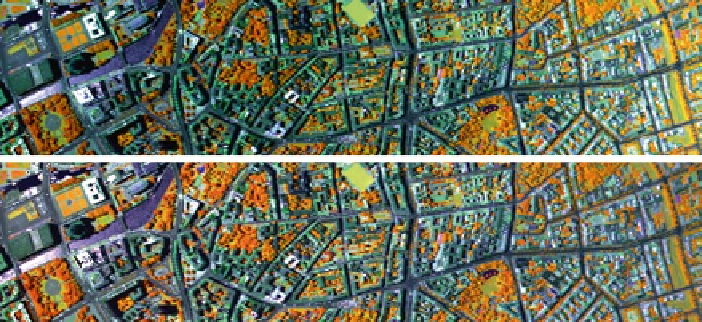Image Processing Reference
In-Depth Information
Fig. 9.1
Comparison of an urban subset before (
top
) and after across-track illumination correction
(
bottom
). R-G-B: band 29-band 80-band 15 (equivalent to a Landsat-TM false color composite
with R-G-B: band 4-band 5-band 3;
white arrow
: flight direction;
yellow arrow
: North)
A view angle dependent correction results in comparable radiances of similar urban
surfaces in across-track direction (Fig.
9.1
).
9.2.1
Radiometric Correction
Usually, hyperspectral data will be distributed as scaled radiance values (e.g. in
µW * cm
−2
* nm
−1
* sr
−1
) and calibration is carried out by the data provider. However,
to compare hyperspectral imagery with field-based measurements and to open up
the pathway towards quantitative analysis, radiance (variable with illumination) has
to be converted to reflectance (invariable for comparable surfaces). This process is
termed “radiometric correction”. Various methods of empirical and parametric radio-
metric pre-processing methods can be distinguished. A simple and useful approach
is the empirical line correction method, relating spectral ground measurements with
radiance values of the respective targets in the imagery. The urban environment offers
abundant invariant and well identifiable targets, which may serve as input from the
image. Applying the resulting band-wise transfer functions leads to values close to
reflectance. However, due to the linear approach non-linear radiometric distortions
will usually not be adequately corrected. Disturbance patterns that vary over the
scene - especially the highly variable water vapor content - can also not be tackled.
Nevertheless, for many cases empirical line corrected data may serve as a valid
input for further processing steps.
If a more precise correction of radiometric properties is required, parametric
approaches need to be implemented. Atmospheric properties are measured, modeled
or estimated to pixel-wise invert the respective disturbance processes and result in
reflectance values. Non-linear effects like the influence of second-order radiometric

